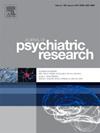Comparative cardiac safety of haloperidol vs. chlorpromazine among people receiving hemodialysis
IF 3.2
2区 医学
Q1 PSYCHIATRY
引用次数: 0
Abstract
Background
Sudden cardiac death (SCD) is > 20 times more likely among individuals receiving maintenance hemodialysis, relative to individuals not receiving hemodialysis. Typical antipsychotics increase risk for QT prolongation and SCD in the general population. The comparative cardiac safety of typical antipsychotics among individuals receiving hemodialysis is unknown.
Methods
This cohort study used an active comparator, new-user design to examine relative cardiac safety of the most frequently prescribed oral typical antipsychotics among individuals receiving outpatient maintenance hemodialysis (2007–2019). Data were obtained from the U.S Renal Data System. The primary outcome was 1-year risk of SCD. Inverse probability of treatment weighted Fine and Gray models estimated adjusted hazard ratios (aHR) and adjusted risk differences (aRDs), with 95 % confidence intervals (CIs), using an intention-to-treat approach. In primary analyses, deaths due to causes other than SCD were competing events.
Results
Among 846,400 maintenance hemodialysis patients (2007–2019), haloperidol (n = 10,813) and chlorpromazine (n = 5800) were the most commonly prescribed oral typical antipsychotics. Among 6266 haloperidol and 3959 chlorpromazine new-users, 662 (9.9 %) and 234 (5.9 %), respectively, experienced SCD by 1-year. Compared to chlorpromazine new-use, Haloperidol new-use was associated with higher 1-year risk of SCD, aHR (95 % CI) = 1.38 (1.21,1.59); aRD (95 % CI) = 2.62 % (−0.27 %, 5.51 %). Analyses of additional cardiac outcomes yielded similar findings.
Conclusions
Haloperidol was the most prescribed oral typical antipsychotic. Haloperidol new-use associated with a higher 1-year risk of SCD and other adverse cardiac outcomes compared to chlorpromazine new-use. Caution and close monitoring are warranted when newly prescribing haloperidol to individuals receiving hemodialysis.
氟哌啶醇与氯丙嗪在血液透析患者中的心脏安全性比较
背景心源性猝死(SCD)是一种疾病。接受维持性血液透析的人比不接受血液透析的人的可能性高20倍。在一般人群中,典型抗精神病药物增加QT间期延长和SCD的风险。在接受血液透析的个体中,典型抗精神病药物的心脏安全性比较尚不清楚。方法本队列研究采用主动比较、新用户设计,研究2007-2019年接受门诊维持性血液透析的个体中最常用的口服典型抗精神病药物的相对心脏安全性。数据来自美国肾脏数据系统。主要终点是1年内发生SCD的风险。使用意向治疗方法,治疗逆概率加权Fine和Gray模型估计调整风险比(aHR)和调整风险差异(aRDs),置信区间为95%。在初步分析中,SCD以外原因导致的死亡是相互竞争的事件。结果2007-2019年846,400例维持性血液透析患者中,氟哌啶醇(n = 10,813)和氯丙嗪(n = 5800)是最常用的口服典型抗精神病药物。6266例氟哌啶醇新使用者和3959例氯丙嗪新使用者中,分别有662例(9.9%)和234例(5.9%)在1年内发生SCD。与氯丙嗪新用药相比,氟哌啶醇新用药的1年SCD风险较高,aHR (95% CI) = 1.38 (1.21,1.59);aRD (95% CI) = 2.62%(- 0.27%, 5.51%)。对其他心脏结果的分析也得出了类似的结果。结论沙哌利多是处方最多的口服典型抗精神病药。新使用氟哌啶醇与新使用氯丙嗪相比,新使用氟哌啶醇与更高的1年SCD和其他不良心脏结局风险相关。当新开氟哌啶醇给接受血液透析的个体时,需要谨慎和密切监测。
本文章由计算机程序翻译,如有差异,请以英文原文为准。
求助全文
约1分钟内获得全文
求助全文
来源期刊

Journal of psychiatric research
医学-精神病学
CiteScore
7.30
自引率
2.10%
发文量
622
审稿时长
130 days
期刊介绍:
Founded in 1961 to report on the latest work in psychiatry and cognate disciplines, the Journal of Psychiatric Research is dedicated to innovative and timely studies of four important areas of research:
(1) clinical studies of all disciplines relating to psychiatric illness, as well as normal human behaviour, including biochemical, physiological, genetic, environmental, social, psychological and epidemiological factors;
(2) basic studies pertaining to psychiatry in such fields as neuropsychopharmacology, neuroendocrinology, electrophysiology, genetics, experimental psychology and epidemiology;
(3) the growing application of clinical laboratory techniques in psychiatry, including imagery and spectroscopy of the brain, molecular biology and computer sciences;
 求助内容:
求助内容: 应助结果提醒方式:
应助结果提醒方式:


